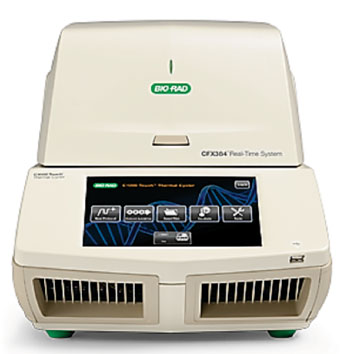High Risk HPV Multiplex Assay Clinically Validated
By LabMedica International staff writers
Posted on 04 Apr 2016
Persistent infection with at least one of the high-risk carcinogenic human papillomavirus (HPV) types is the primary risk factor for the development of cervical cancer and HPV is found in virtually all cases of cervical cancer and precursor lesions.Posted on 04 Apr 2016
Providing clear information about infected HPV genotypes in the stage of infection, clearance, and persistence is important to manage patient monitoring and treatment; however, conventional cytology tests do not determine HPV infection, but detect only cytological abnormality.

Image: the CFX96 real-time thermocycler (Photo courtesy of Bio-Rad).
Scientists at the Catholic University of Korea (Seoul, Republic of Korea) collected 1,137specimens from Korean women that were randomly selected from the liquid-based cervical specimens between January and June 2014. All specimens were collected with a cytobrush, and were placed in a Huro Path liquid-based cytology sampling device (CelltraZone; Seoul, Republic of Korea). They were stored at -70 °C until HPV testing. Each specimen was divided into two aliquots and then used for HPV detection tests. The cervical cytological examination was performed by experienced cytopathologists.
The investigators used the Anyplex II HPV HR detection kit (Seegene Inc.; Seoul, Republic of Korea) which is a new, multiplex, real-time polymerase chain reaction assay to detect individual 14 high-risk (HR) human papillomavirus (HPV) types in a single tube. For each sample, HPV detection and genotyping were performed using a CFX96 real-time thermocycler (Bio-Rad; Hercules, CA, USA). They compared the assay with the Hybrid Capture 2 (Qiagen; Valencia, CA) using the non-inferiority score test in a routine cervical cancer screening setting. The intra laboratory and inter laboratory agreements of HPV HR were also evaluated.
The scientists found that overall agreement between the two assays was 92.4% (1,051 of 1,137) with a κ value of 0.787. Clinical sensitivity of HPV HR for high-grade squamous intraepithelial lesions and cervical intraepithelial lesions grade 2 or worse was 94.4% and 92.5%, respectively. The respective values for Hybrid Capture 2 were 93.1% and 87.5%. Clinical sensitivity and specificity of HPV HR were not inferior to those of Hybrid Capture 2. The HPV HR showed good intra laboratory and inter laboratory reproducibility at 98.0% and 97.4% respectively.
The authors concluded that their data indicate that the HPV HR assay was highly comparable to HC2 for clinical equivalence and reproducibility based on international guidelines. The individual typing information for 14 hrHPV genotypes, including HPV-16 and HPV-18, provided by the HPV HR can be an important tool in patient management. The study was published in the March 2016 issue of the journal Archives of Pathology & Laboratory Medicine.
Related Links:
Catholic University of Korea
CelltraZone
Bio-Rad














